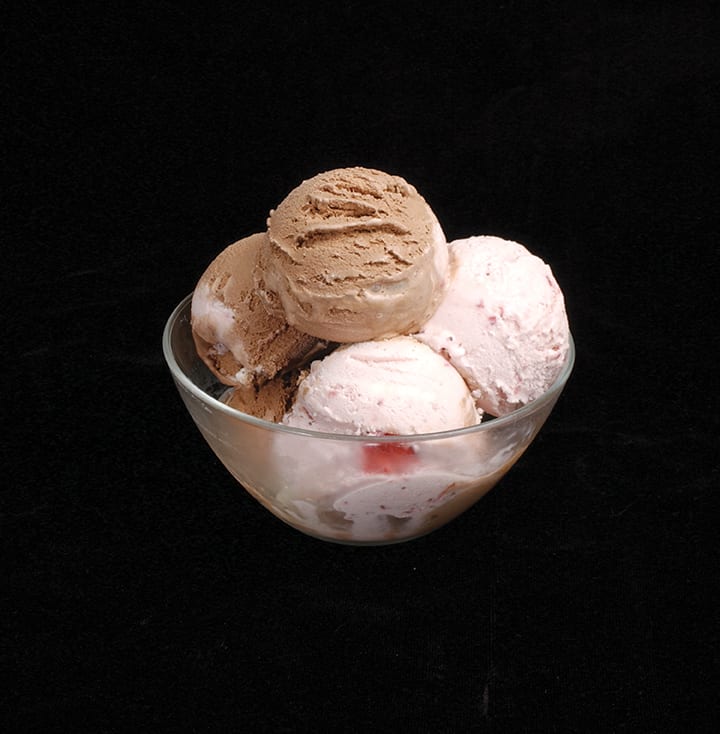Jackie Black considers the wider issues of morality, justice and innocence, recreating the last meals of those subjected to capital punishment in Texas.
Jackie Black’s photographs examine the ambiguity of mortality in American culture. On display at the Parrish Art Museum, New York, Last Meal is the artist’s commentary on capital punishment. A series of powerful 12 x 12-inch images recreate the last meals and statements of 23 indi- viduals who were tried, convicted and executed in Texas under capital punishment between 1984 and 2001. At first glance, they read as staged food photos on a glossy diner menu. However, suspended against stark black backgrounds in a gallery setting – with no suggestion of social or human interaction – the images are transformed into macabre still lifes. Savannah Petrick, Curatorial Assistant and Publications Coordinator, discusses Black’s work in the context of the USA today – in a country that has had 170 exonerations since 1973, and 1,522 executions since 1976.

A: By 2019, 106 countries had abolished the death penalty, but in 2020, 53 countries still practice capital punishment. What role does it play in the USA today?
SP: Prior to the election of Donald Trump, it seemed the USA was on its way to becoming a less punitive nation; in 2016, the Pew Research Center reported that public support of the death penalty had fallen to 49% – the lowest it has been since the 1970s. Then, during the 2016 election – alongside Trump’s “tough on crime” campaign – all three states with death penalty referendums voted in favour of capital punishment: California and Oklahoma voted to keep it, and Ne- braska voted to reinstate it (figures taken from Jackie Wang’s Carceral Capitalism, 2018). More concerning is the recent resumption of federal executions: on 14 July 2020, the Justice Department executed death row prisoner Daniel Lewis Lee via lethal injection, ending a 17-year informal moratorium on federal capital murder. Months into the current movement for social and racial justice – against police brutality and state-sanctioned violence – the issue remains largely absent from public discourse. In the USA, blackness is often conflated with guilt and criminality. Our country is finally acknowledging this fact and attempting to dismantle the systems that enable it. This is a good thing, but it’s also where the ambiguity of mortality comes into play. The anger propelling the Black Lives Matter movement is often only ignited when there’s a precondition of innocence: Ahmaud Arbery was out for a jog, Breonna Taylor was asleep in her home, Botham Jean was having ice cream on his couch, Stephon Clark was standing in his grandmother’s backyard, and 12-year-old Tamir Rice was playing in a park. If the victim isn’t totally “innocent” (a.k.a. non-threatening), then it’s the discord be- tween the severity of the punishment – death – and the pettiness of the alleged crime, be it selling loose cigarettes or paying with a counterfeit bill, that garners a public reaction.
A: How does the Last Meal series interact with this history?
SP: Prison abolitionist Ruth Wilson Gilmore writes: “Whilst saving anyone is a good thing to do, to try to assert innocence as a key political strategy is to turn a blind eye to the system and how it works. [The problem] is not to figure out how to determine or prove the innocence of certain individuals, but to attack the general system through which criminalisation proceeds.” The photographs in Last Meal do this with subtlety. Jackie Black does not overreach; she does not attempt to exonerate any of the individuals, nor do the pictures explicitly address ethical issues surrounding the death penalty. However, in the book ac- companying the series, the artist presents facts and figures about capital punishment, as well as the last statements and biographical information about the 23 individuals, such as age, occupation and level of educations, where available. The exhibition at Parrish likewise includes this information and the most recent fact sheet published by the Death Penalty Information Center, alerting visitors to the myriad ways in which the death penalty is inhumane.

A: The images are at once incredibly similar, especially in their composition, but entirely different with the foods they depict. How do you feel the subtlety be- tween them creates their stark power?
SP: The pictures are similar in that they all document last meal requests of individuals on death row in Texas executed between 1984 and 2001. Texas actually abolished the traditional last meal request in 2011, after Lawrence Russell Brewer requested a huge meal that he did not eat. Texan Senator John Whitmire said of his decision: “Enough is enough. It is extremely inappropriate to give a person sentenced to death such a privilege. It’s a privilege which the perpetrator did not provide to their victim.” (Texas Jails Abolish Last Meals After Uneaten Banquet, BBC, 23 September 2011). Prior to this decision, no dollar limit was placed on an inmate’s last meal request, but food items had to be readily available in the prison kitchen, and no alcohol or tobacco were permitted. I would posit that the similarities between some last meals are due to statewide limitations. The disparities between, say, David Wayne Stoker’s request for two double-meat cheeseburgers, french fries, and ice cream, and Robert Anthony Madden’s request for his last meal to be given to a homeless person (request denied), might reflect a difference in interpretation and attitude toward impending execution. Jackie Black focuses on Texas because the state is responsible for almost 40% of all federal executions in the USA. Her selection of individuals is reflective of statewide and national patterns; nine of the 23 individuals in Last Meal are black; 44.3% of inmates on death row in Texas are black, though the state’s black population is just under 13% (Texas Department of Criminal Justice). Likewise, as of 1 January 2020, 41.6% of the current USA death row population is black, whilst the black population in the USA is just 13.4%.
A: The artist utilises a sterile black background, stripping the meals back, showcasing them without adornment or extra detail. What does this say about the presentation of the individuals in relation to crime? SP: Though the meals are presented on a plain back- ground, the images aren’t shown anonymously; each picture is paired with the last statement and execution date of the individual, as well as background information – such as level of education and occupation – where available. The alleged crimes are, notably, left out. I believe this choice reflects Black’s desire to actually preserve the humanity of the individuals, since humanity and innocence are in- extricably linked in American culture. At Parrish, we made the curatorial decision to likewise omit the alleged crimes in support of the artist’s goal. To me, the stage-lit meals become ominous on the stark black background – carrying with them a sense of doom that is appropriate for the occasion. With no purpose other than human consumption, the items appear as leftovers of a rapture.

A: Which images do you feel, most successfully, instil empathy and why? Do they all have the exact same effect, or are there some that have more impact?
SP: I find Odell Barnes, Jr.’s last meal request for “Justice, Equality, World Peace” and Robert Anthony Mad- den’s request for his last meal to be given to a homeless person (request denied) to be the most successful, both for their purity (I too am guilty of linking innocence with humanity) and for their textual composition, which offers a reprieve from the diner menu aesthetic of the other photographs. There is also something quite compelling about the defeatist simplicity of Charles Francis Rumbaugh’s request for one flour tortilla and Charles William Bass’ request for a plain cheese sandwich, both of which look awfully pitiful on the black background.
A: Beyond the food, these meals signify something much larger. How do they reflect the emotions of the individual in question – their psychological states, guilt, resentment, or in many cases, innocence?
SP: Empathy comes in many forms. I can relate to the more indulgent meals, such as David Allen Castillo’s request for 24 soft shell tacos, six enchiladas, six tostadas, two whole onions, five jalapeños, two cheeseburgers, one chocolate shake, and one quart milk – a request so large it’s staged as the only diptych in the exhibition. Then there’s Stacey Lamont Lawton’s request for one jar of dill pickles and Gerald Lee Mitchell’s request for one bag of assorted Jolly Ranchers, both of which resonate for their oddity. The case that has the greatest impact for me, personally, is that of James Beathard: after his trial, the prosecution’s key witness recanted his testimony, casting doubt on an already faulty case. Three members of the parole board recommended clemency for Beathard. Nonetheless, he was executed. His last meal was fried catfish, fried chicken, french fries, onion rings, green salad, fresh carrots and a coke.

A: The images may, at first, seem banal, but viewers are pulled in through morbid curiosity. How does Black pique audiences’ interests, and to what end?
SP: The photographs are undoubtedly inspired by Dutch Vanitas, or symbolic works of art showing the transience of life, the futility of pleasure and the certainty of death. The seeming fruitlessness of pleasure is particularly apparent in the photographs I previously describe as “awfully pitiful” in that the individuals seem to have already resigned from their lives on earth. Widespread fascination with last meal requests is just another form of American consumerism, not so different from the way we sensationalise the lives of celebrities. It’s an obsession with someone’s life we perceive to be vastly different from our own, and I can understand why people criticise this obsession as being nothing more than voyeurism. But we are reminding audiences that capital murder does still occur, carving out space for the debate in our country’s larger movement for social justice.
Jackie Black: Last Meal Until 31 January Parrish Art Museum, New York
Lead Image: Jackie Black (American, b. 1958), Karla Faye Tucker: Banana, peach, and garden salad with ranch dressing from the Last Meal series (2001–2003). Archival pigment on paper, 12 x 12 inches. Parrish Art Museum, Water Mill, N.Y., Museum purchase with funds provided by the Bessemer Trust. Photos: Courtesy of the artist.
1: Jackie Black (American, b. 1958), William Joseph Kitchens: Half dozen sunny side up fried eggs, 8 pieces of pan sausage, 6 slices toast with butter and grape jelly, crispy hash browns, milk, orange juice from the Last Meal series (2001–2003). Archival pigment on paper, 12 x 12 inches. Parrish Art Museum, Water Mill, N.Y., Museum purchase with funds provided by the Bessemer Trust. Photos: Courtesy of the artist.
2: Jackie Black (American, b. 1958), Johnny Frank Garrett: Ice cream
from the Last Meal series (2001–2003). Archival pigment on paper, 12 x 12 inches. Parrish Art Museum, Water Mill, N.Y., Museum purchase with funds provided by the Bessemer Trust. Photos: Courtesy of the artist.
3: Jackie Black (American, b. 1958), Billy Conn Gardner: Hamburger,
French fries, tea and any dessert from the Last Meal series (2001–2003). Archival pigment on paper, 12 x 12 inches. Parrish Art Museum, Water
Mill, N.Y., Museum purchase with funds provided by the Bessemer Trust. Photos: Courtesy of the artist.
4: Jackie Black (American, b. 1958), Charles William Bass: Plain cheese sandwich from the Last Meal series (2001–2003). Archival pigment on paper, 12 x 12 inches. Parrish Art Museum, Water Mill, N.Y., Museum purchase with funds provided by the Bessemer Trust. Photos: Courtesy of the artist





